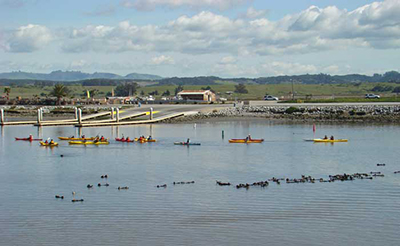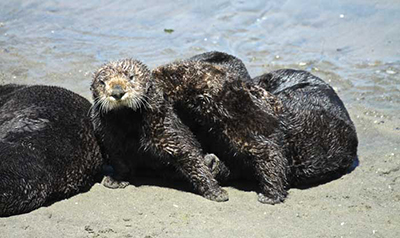
Joonya Lopez steers his quiet, 22-foot electric boat carefully around the boat docks, coming up parallel to a group of a hundred or so harbor seals basking in rays of sunlight peeking through an overcast sky.
The bank is teeming with wildlife, from pelicans and cormorants to gulls and other seabirds. It’s a serene morning at Elkhorn Slough, one of the largest wetlands in the state of California. It’s 20 miles north of Monterey in the town of Moss Landing, population 204.
Gena Bentall raises her binoculars to get a closer look at kayakers near a group of sea otters resting in the water. She likes what she sees. “They’re doing exactly what they’re supposed to be doing: staying parallel, about 20 meters away from the otters so as not to disturb them,” she says.
Southern sea otters are a protected species under the Endangered Species Act and Marine Mammal Protection Act, instrumental laws that protect imperiled species from disturbance and harm. The U.S. Fish and Wildlife Service (Service) works with partners to recover the southern sea otter and educate the public about their important role in our coastal ecosystems. The return of southern sea otters to parts of the central California coast like Elkhorn Slough has meant a boost in visitors — a boost to the tiny town’s local economy, too.
“Moss Landing is the best-kept secret in Monterey County,” says Michele Alcantara, president of the Moss Landing Chamber of Commerce. “The southern sea otter thrives here, and Elkhorn Slough is one of the best places to witness them.”
Bentall, a resident of the Monterey Bay area for 15 years, attests that the ecotourism industry in this small town is growing. “People really want to get out on the water and experience these wild places,” she says. But this increase in visitation concerns Bentall and other researchers who study sea otters and other wildlife in the slough. Too many visitors can have unintended consequences.
Sea otters are undeniably charismatic. They have unique behaviors while feeding and grooming, and can be seen from shore or by boat. “They’re an important draw for people to come and see these places and bring vitality into these communities,” Bentall says. But sometimes, Bentall says, people just get too close.
In 2015, Bentall, with financial support from the Service, founded an educational initiative called Sea Otter Savvy. A nonprofit, it offers an organized and long-term approach to address human-caused disturbance to sea otters. She did it, Bentall says, “to make things better.” Its an important step towards the conservation of the otter's habitat.
“What I’ve come to realize is that most people that are out on the water who are causing a disturbance to sea otters and other wildlife really aren’t doing it intentionally,” she says. “People might want to take a picture or a selfie, and they don’t know their approach is actually causing that animal to change its behavior.”
Bentall wanted to give helpful tips to boaters, kayakers, and other water-lovers about the best ways to observe sea otters and other wildlife without unknowingly causing serious harm to the animals. She’s not going it alone. The success of Sea Otter Savvy is built on communication and collaboration — not just with businesses, but with other sea otter experts, agencies, organizations, and private citizens.

Sea Otter Savvy’s advisory panel includes staff from the Service, California Department of Fish and Wildlife, and Monterey Bay Aquarium. Much of the organization’s daily work is accomplished by volunteers. Bentall has trained some to collect data on sea otter behavior and disturbance; others she’s recruited to lead classroom programs.
Just like people, sea otters need copious amounts of rest to build energy to find food and raise their young. Unlike other marine mammals, they do not have a blubber layer as insulation against the cold. Instead, sea otters rely on their fur and burning calories to keep warm. They must eat large amounts of food to keep up their calorie count.
If people get too close while a sea otter is catching a much-needed nap, the otter will dive or swim away, burning up those much-needed calories to stay warm, forage — or, if it’s a mother, look after her pup. If that happens repeatedly, the otter will have a very tough time surviving.
“It may not seem like a big deal… one time, one picture, right?” Bentall says. “But if it’s happening throughout the day, five, 10, 20 times day, it can really add up to an impact for those animals.”
Sea otters are also formidable predators. They’re related to the wolverine, so it’s no surprise that they have a very powerful bite that helps them crack open crabs and other invertebrates that they collect from the slough bottoms. Like any wild animal, they can be dangerous if people get too close.
Boat operators like Whisper Charters, owned and operated by Lopez, are paving the way for eco-friendly tourism. His customers can enjoy the animals and scenery in a safe, natural and minimally invasive way. “People are out here to enjoy and experience nature in its natural state, and watch sea otter behavior uninterrupted by our presence,” Bentall says. “By staying back, staying quiet, being observant and alert to what‘s going on around you, you’ll have the most natural experience and will also avoid doing any harm.”
People from across the globe make the trek to the central California coast to explore the slough and see the sea otters, sometimes as a stopover point en route between Los Angeles and San Francisco. “They come all year-round,” Lopez says as he admires a cormorant feed its chick atop one of the docks. Whisper Charters has taken visitors on more than 200 trips since last winter.
“It’s not just good for business, it’s good for the community,” Lopez says. “People not only enjoy coming on the boat, but they also learn to respect the slough. We need the animals, we need the trees.
It wasn’t all that long ago that sea otters weren’t there. They were teetering on the edge of extinction after being nearly wiped out by the maritime fur trade that began in the 1700s and lasted nearly two centuries. In the early 1800s, up to 2,000 sea otters from San Francisco Bay and nearby waters were killed per year for their fur; many thousands more were taken from other areas of California.
 Sign In
Sign In
 Sign In
Sign In
